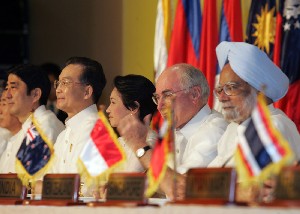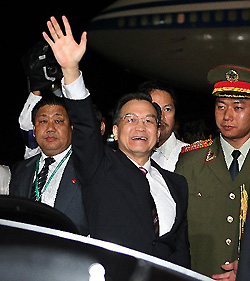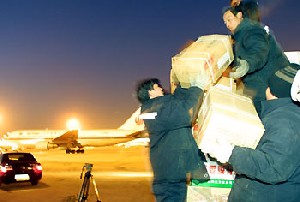China’s Strategic Southeast Asian Overture
By David Fullbrook
BANGKOK - If all goes to plan, China will for the first time ever in July host joint military exercises with troops from the 10-member Association of Southeast Asian Nations (ASEAN), the strongest indication yet that Beijing’s recent economic charm offensive toward the region is starting to pay real strategic dividends.
Beijing extended the invitation during last month’s ASEAN summit, innocuously for peacekeeping training and disaster-zone management and reconstruction. ASEAN is reportedly still mulling the offer, but many security analysts believe that the group is poised to accept the historic offer and that Beijing would not have extended the historic offer if the chances of acceptance weren’t high.

Japanese Prime Minister Abe Shinzo (left), Chinese
Premier Wen Jiabao (second left), Philippines President
Gloria Macapagal-Arroyo (third left), Indian Premier
Manhmohan Singh (right) among leaders of ASEAN
nations and observers in January 2007.
Beijing’s friendly overture would appear to mark a significant strategic departure, with China moving toward more limited multilateralism rather than its historical unilateralism to advance its regional-security interests. Developing cooperation with neighboring militaries would hypothetically help China secure its porous southern periphery and free up more resources for projecting its power and influence globally.
China is implementing what appears to be a two-phased strategy toward the region, characterized first by promoting growing economic and investment linkages and now by offering limited military assistance. It’s a well-calculated gambit aimed at stealing a march from the United States, specifically through the development of competing linkages and personal relationships with individual ASEAN members’ militaries.
China’s strategic overtures obviously have the US on edge. This week, Washington announced that it would indeed stage its annual “Cobra Gold” joint military exercises with Thailand. Those exercises, the largest in Southeast Asia and which have in the past included troops from Singapore and Malaysia and observers from China, had been in doubt because US law prohibits certain types of military assistance to governments that seize power through anti-democratic means - as was the case with last September’s Thai coup. Soon thereafter, Beijing attempted to fill the military gap by offering Thailand US$49 million in military aid and training.

A Thai soldier and a U.S. soldier undergo training
during Cobra Gold 2005.
Significantly, China has traditionally shied away from formal military ties with regional countries that could be construed as alliances. Likewise, ASEAN has steadfastly avoided entering formal security pacts and collective defense mechanisms. The group of pro-Western states was founded in 1967 partially to guard against the spread of communism, which China was then promoting - often through disruptive means. They had relied heavily on US strategic assurances to counterbalance China’s, as well as the Soviet Union’s, influence beginning as early as the 1950s.
Beijing arguably started to embrace military multilateralism in the late 1990s with the formation of the Shanghai Cooperation Organization, which loosely links four Central Asian states, Russia and China together through combined training and patrols in fighting against terrorism, extremism and separatism. China’s trade and investment have since risen sharply in Central Asia, giving it greater influence to counter America’s regional strategic designs, which included military bases in Uzbekistan for a few years and the ongoing use of a base in Kyrgyzstan, on China’s border.
Strategic Passageway

Wen Jiabao arrives at the ASEAN summit
in January 2007.
If diplomatically possible, China would doubtless like to lead a similar security organization for Southeast Asia - a particularly strategic passageway for China’s booming seaborne trade with India, the Middle East, Africa and Europe, which passes through the region’s busy and congested shipping lanes.
Moreover, Southeast Asia is fast emerging as an important supplier of China’s industrial commodities and energy, and the region as a whole now runs a trade surplus with China. China is set to displace the US as ASEAN’s top trade partner as early as next year, a position the Sino-ASEAN free-trade agreement should cement when it comes into force in 2010. Meanwhile, there is still no sign of a counterbalancing free-trade proposal with the US.
To be sure, longtime disputes among ASEAN’s member states, driven alternately by nationalism, territorial disagreements and historical rivalries, have given the lie to the group’s pretense of harmony and have complicated China’s attempts to push through universally accepted proposals - particularly on military matters. The United States’ still-strong influence plus ASEAN’s traditional distrust of multilateral security arrangements have meant China has had to tread carefully for the past decade.
To build confidence, China is now an active and engaging participant in the grouping’s various talk shops, including significantly the ASEAN Regional Forum (ARF), which also includes the US, Japan and India among its participants. ARF has long discussed pertinent regional-security issues, but only toward the end of building confidence and specifically not by introducing any binding conflict prevention, conflict resolution or disarmament pacts.
ASEAN’s goodwill toward China rose significantly in 2003, when Beijing agreed to a code of conduct toward easing territorial disputes among ASEAN members and China over the Spratly Islands, which some think are rich in oil. All sides recently reaffirmed their support for the code, which has helped to ease tensions in recent years. Moreover, China was quick to send US$60 million worth of aid and supplies to regional counties affected by the 2004 tsunami.

Workers in Beijing load goods for tsunami victims
in December 2004.
Though thoroughly outshone by the United States’ - and to a lesser degree Japan’s - rescue and financial response, Beijing’s benevolent-big-brother posturing toward the region represents a diplomatic course shift that started in the wake of the 1997-98 Asian financial crisis, when it offered $1 billion in financial assistance to regional countries. The US, in comparison, was widely criticized across the region for its perceived opportunistic approach in dealing with the region’s suddenly cash-strapped governments.
China also arguably displayed its support for ASEAN last month by making rare use of its veto at the United Nations Security Council, killing a US-sponsored resolution condemning Myanmar’s rights record, which would have badly embarrassed the entire grouping on a global stage.
The US has so far wholly failed to match China’s softly-softly approach toward ASEAN, which has significantly degraded the United States’ bilateral relations with particular regional countries. The US administration’s emphasis on securing counter-terrorism cooperation from countries in the region has taken precedence over most cordial diplomacy and reportedly rendered bilateral relations awkward with Muslim-majority countries such as Indonesia and Malaysia.
Both those countries have recently rejected as an infringement of sovereignty Washington’s offer to send US Navy ships to help crack down on the pirates in the congested Strait of Malacca - which coincidentally is also where an estimated 75% of China’s fuel imports travel through.
China has notably not made any hard demands on ASEAN, in effect practicing the group’s own adherence to “non-interference” in other countries’ domestic affairs. At the same time, Beijing is now adroitly and aggressively leveraging its recent successful diplomacy and growing economic linkages to overcome historical distrust and build new strategic assurances aimed at displacing the United States’ strategic influence over the region. And judging by ASEAN’s warm response to its recent overtures, China’s grand designs are proceeding very much as planned.